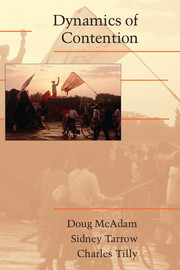Preface and Acknowledgments
Published online by Cambridge University Press: 05 June 2012
Summary
Our enterprise began with a failed coup. In 1995, friends, students, and collaborators of Chuck Tilly organized a gathering in Amsterdam that was supposed to ease Tilly into retirement. He failed to get the message. As second best, McAdam and Tarrow decided to divert Tilly temporarily from his other projects into one that would minimize the evils he might otherwise inflict on the world. This book is the result.
Uncertain of their ability to coerce Tilly into compliance with their schemes, the two conspirators plotted to expand their cabal. Wouldn't it be great, they mused, if scholars from the related fields of social movements, revolutions, nationalism, and democratization could find a venue in which to explore the possibilities for synthesis across these nominally distinct subfields? That conversation led to a proposal to the Center for Advanced Study in the Behavioral Sciences for a one-year Special Project to be devoted to the kind of exploration and synthesis they had in mind. After enlisting Tilly as co-conspirator, a proposal was drafted, ably vetted by Phil Converse and Bob Scott (then Director and Associate Director of the Center), and approved by both the Center's Advisory Committee on Special Projects and its Board of Trustees. The plot had thickened!
Once the Special Project began, our broader enterprise took a fateful turn. Realizing faster than we did how excessive were our aims, Bob Scott encouraged us to seek support that would allow us to stretch the project over a longer time frame.
- Type
- Chapter
- Information
- Dynamics of Contention , pp. xiii - xviiiPublisher: Cambridge University PressPrint publication year: 2001
- 1
- Cited by



